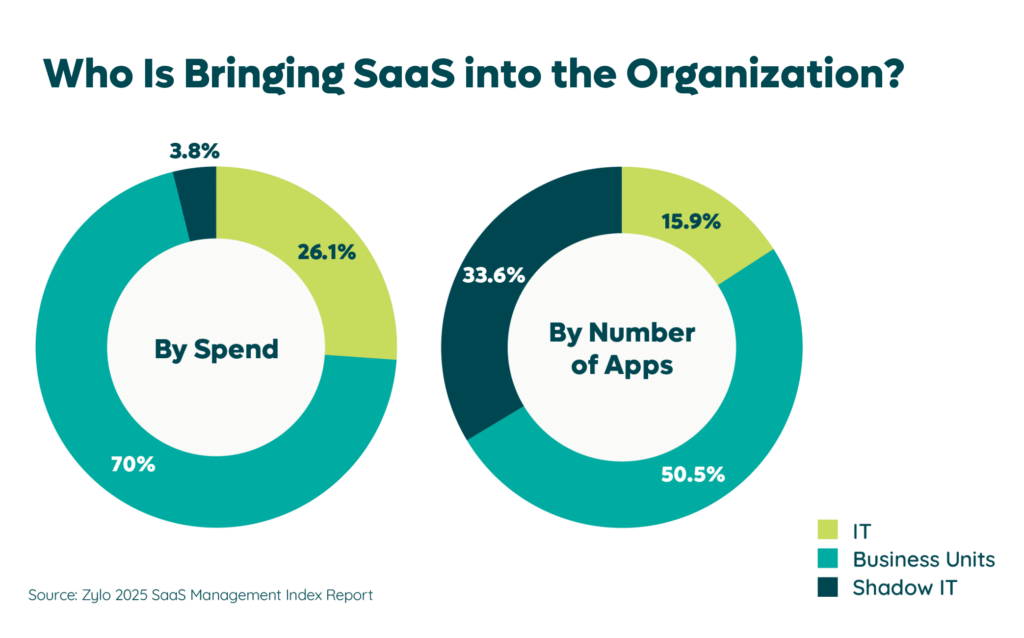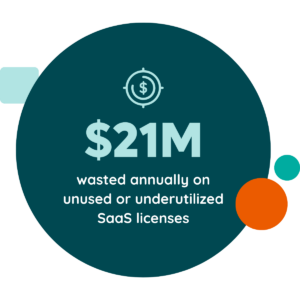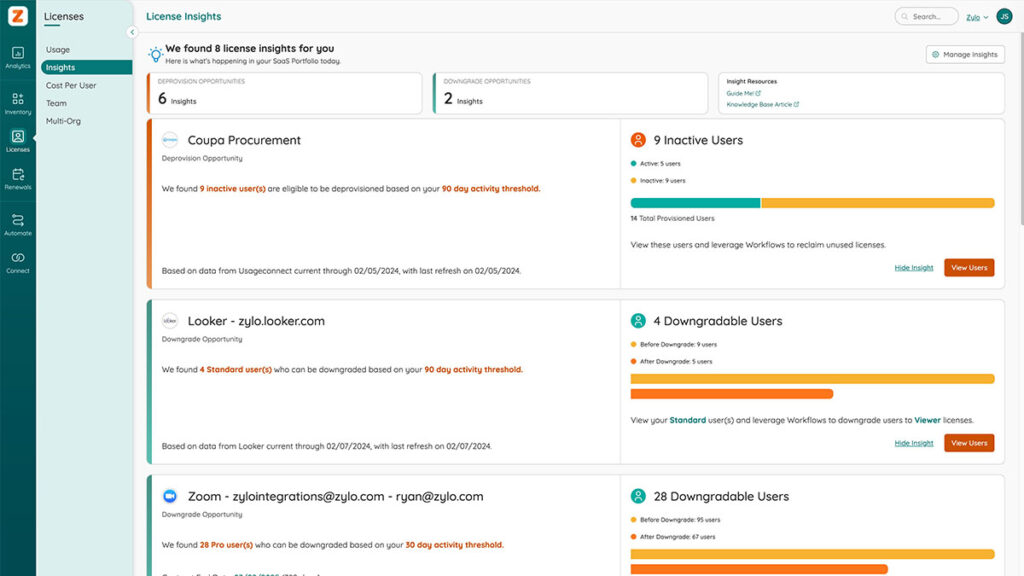Table of Contents
As organizations increasingly adopt cloud-based solutions, the role of Financial Operations (FinOps) has evolved. This shift is driven by the rapid proliferation of SaaS applications across business functions, which, while increasing operational flexibility, also introduces significant cost management challenges.
For IT and Software Asset Management leaders, understanding the intricacies of SaaS Management has become imperative. The growth in SaaS spend is now a substantial line item in IT budgets, impacting overall financial planning and resource allocation.
Effective SaaS Management prevents fiscal waste and ensures investments stay aligned with business needs and usage, optimizing cost and performance. This specialized discipline within FinOps addresses these needs, guiding leaders to navigate the growing SaaS landscape with more precision and foresight.
The Rapid Growth and Complexity of SaaS in Organizations
Spending on IT resources has undergone a transformation over the last few decades. Traditionally, FinOps focused on cloud infrastructure costs, which provided a predictable expense model based on consumption.
With the rise of SaaS, there’s now a new layer of financial complexity due to diverse pricing models, rapid adoption rates, and decentralized procurement practices. As a result, FinOps must adopt a broader focus and encompass SaaS expenditures that are becoming a significant financial concern.
A Gartner study highlights the financial implications of inadequate SaaS Management. They project that through 2027, organizations without centralized visibility and coordinated management of their SaaS portfolios are at risk of overspending by at least 25%. This overspend often comes from unused entitlements and overlapping tools frequently bought outside IT’s procurement processes.
Guide to Managing SaaS Costs
Learn MoreThe Birth of a Discipline: SaaS Management
As SaaS continues to grow within enterprise IT spending, SaaS Management emerges as a critical discipline within FinOps. While it shares core principles with traditional FinOps—such as cost transparency, budget alignment, and value optimization—SaaS Management introduces specific strategies to handle the unique challenges posed by SaaS solutions. These challenges include:
- Managing recurring costs
- Optimizing software licenses based on usage
- Controlling shadow IT
This nascent discipline requires a tailored approach that goes beyond the general principles of cloud cost management and focuses on the specific nuances of SaaS tools. For a deeper understanding of FinOps and how it integrates with SaaS Management, see our previous discussion, What is FinOps?
Now, as a FinOps pro, what do you need to know about SaaS Management? We break down five areas to pay attention to.
5 Things FinOps Pros Need to Know About SaaS Management
#1 – The Hidden Costs of SaaS
While SaaS solutions are scalable and easy to integrate, they often come with less obvious costs that can impact your IT budget.
Beyond licensing fees, companies must account for implementation costs, which may involve complex setups and custom configurations for specific needs. Training expenses may be necessary to ensure that staff can effectively utilize new SaaS tools. Last, ongoing integration costs can arise, as your tools must continuously align with existing systems.
Another significant financial burden comes from shadow IT—software and services acquired and used without explicit IT approval. This phenomenon is not just a security risk; it also leads to substantial untracked expenditures.

A striking 84% of software purchases occur outside the traditional IT procurement process, making it challenging for organizations to maintain a clear overview of their SaaS spending. This lack of oversight often results in duplicate subscriptions, shelfware, and underused licenses, worsening financial inefficiencies.
#2 – How to Optimize SaaS Licensing for Cost Savings
Optimizing SaaS licensing is crucial for avoiding financial waste and aligning costs with actual usage. Our data shows that the average organization wastes an average of $21M on SaaS annually. As such, it’s understandable why license optimization is a critical component of SaaS Management.
 Rightsizing licenses—adjusting the number and type of licenses to match user needs—is a fundamental strategy in this process. It entails cutting excess licenses and reassessing the service tier for different user groups within an organization.
Rightsizing licenses—adjusting the number and type of licenses to match user needs—is a fundamental strategy in this process. It entails cutting excess licenses and reassessing the service tier for different user groups within an organization.
To effectively rightsize SaaS licenses, organizations should identify and reallocate unused licenses to new users instead of purchasing new ones. Doing so not only keeps you from buying more licenses unnecessarily, but gives you a new baseline of what you actually need.
If users have an enterprise license but only need basic features, downgrade licenses to lower service tiers. This can yield significant savings, especially when current subscriptions exceed user requirements.
Moreover, negotiating better terms with vendors can be highly effective, particularly when armed with data that demonstrates a lower-than-anticipated utilization. Taking this data-driven negotiation approach helps secure more favorable pricing and contract terms, further reducing unnecessary SaaS costs.
#3 – Discovery Is the Foundation of SaaS Management
Effective SaaS Management begins with discovery, a fundamental step that ensures organizations have complete visibility into their SaaS landscape. This visibility is crucial for identifying all of your SaaS subscriptions, understanding usage patterns, and managing costs.
Without a comprehensive discovery process, companies may struggle with redundant applications, unmanaged spend, and potential security risks due to unauthorized software use.

The dynamic nature of SaaS usage and the frequent addition of new applications—often without formal oversight—requires a continuous discovery approach. On average, organizations add around six new applications per month, reflecting the modern ease of SaaS adoption.
Continuous discovery helps organizations keep pace with these changes, ensuring every new tool immediately integrates into the overall SaaS Management strategy.
#4 – Using Usage Data to Make Informed Decisions
Optimizing your licenses can reap huge financial rewards, as previously discussed. But, that Usage data also offers detailed insights to help you make more strategic decisions, manage access, and create a more efficient tech stack. It allows organizations to identify underutilized resources, adjust SaaS expenditures, and ensure that investments stay aligned with business needs.
Key strategies utilizing usage data include:
- License Optimization: Maximizing usage and adoption helps ensure you make the most of every dollar you spend. While this includes cost savings, you’re also using apps more efficiently, which can improve operations and collaboration across the business.
- Application Rationalization: With redundancy and duplicate contracts common in portfolios today, it’s important to assess the utility and value of all your SaaS applications. Rationalization helps eliminate redundant tools and focuses spending on applications that provide the best return on investment. Going through this process, you can determine which apps you should keep, replace, or consolidate.
- License Audits After Employee Departure: Regular audits are essential to understand which licenses are still held by users no longer at your company. By reclaiming those licenses, you can reduce unnecessary costs and mitigate security risks associated with unused accounts.

A SaaS Management Platform (SMP) plays a pivotal role in centralizing usage data and providing actionable insights. It aggregates data across all of your SaaS tools, enabling more informed decision-making through comprehensive analytics and reporting features. By leveraging an SMP, you can streamline SaaS Management processes, enhance security compliance, and optimize software spend.
#5 – The Importance of SaaS Governance
Just as robust Cloud Policy & Governance capabilities have been critical in FinOps for managing cloud infrastructure costs and compliance, similar governance structures are increasingly essential for SaaS Management.
SaaS governance focuses on establishing controls that manage an organization’s lifecycle of SaaS applications. Using a governance framework is vital for purchasing software efficiently, enhancing security, and optimizing spending as SaaS applications become more prevalent and complex.
Key governance strategies for effective SaaS Management include:
- Defining Clear Roles and Responsibilities: It’s vital to establish who manages SaaS tools, including procurement, deployment, management, and review. Clear delineation of responsibilities ensures accountability and helps prevent the proliferation of shadow IT.
- Setting Approval Workflows: Implementing a structured approval process for acquiring new SaaS tools helps maintain budget control and align purchases with organizational needs and policies. Approval workflows also ensure that every new software acquisition is justified, documented, and aligns with existing IT infrastructure.
- Ensuring Compliance with Security and Privacy Standards: As SaaS applications often handle sensitive data, adhering to strict security and privacy standards is imperative. SaaS governance should include regular audits, compliance checks, and updates to security policies to protect against data breaches and ensure compliance with regulations like GDPR and HIPAA.
These governance measures streamline SaaS Management and bolster an organization’s overall security posture and financial efficiency.
Evolving Your SaaS Governance Framework for the Digital Workplace
Learn MoreReady to Go Further?
Whether you’re just starting to incorporate SaaS governance into your FinOps practices or seeking to optimize an existing framework, our resources can guide you through every step. Since effective SaaS Management begins with visibility, check out our guide on how SaaS Discovery Drives Visibility and Insights into Your Portfolio.

